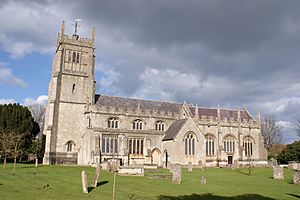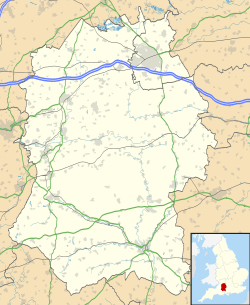St Michael's Church, Melksham facts for kids
Quick facts for kids St Michael's, Melksham |
|
|---|---|
| Church of St Michael and All Angels | |
 |
|
| 51°22′21″N 2°08′27″W / 51.3726°N 2.1409°W | |
| OS grid reference | ST903637 |
| Location | Melksham, Wiltshire |
| Country | England |
| Denomination | Anglican |
| History | |
| Status | Parish church |
| Architecture | |
| Functional status | Active |
| Style | Perpendicular |
| Years built | 12th, 14th–16th centuries, 1845 |
| Administration | |
| Parish | Melksham |
| Deanery | Bradford on Avon |
| Archdeaconry | Wilts |
| Diocese | Salisbury |
| Province | Canterbury |
St Michael's Church is a historic Church of England church located in Melksham, a town in Wiltshire, England. It is also known as the Church of St Michael and All Angels.
This church stands about 200 meters northwest of Melksham's main marketplace. Its history goes back to the 12th century. Over the years, the building was changed and made bigger in the 14th and 15th centuries. It was also repaired and updated in the 19th century. Today, it is a very important building, listed as Grade II*. This means it is a particularly important building of more than special interest.
Contents
History of St Michael's Church
The first mention of a church in Melksham was in the Domesday Book of 1086. This was a big survey ordered by William the Conqueror to record everything in England.
Since 1220, the church has been connected to Salisbury Cathedral. This connection continues even today.
Church Design and Architecture
St Michael's Church has several main parts. It includes a chancel (the area around the altar) and a long main area called a nave with five sections. On either side of the nave are north and south aisles. There are also chapels on the north and south sides, and a tall tower at the west end.
The famous architectural expert Nikolaus Pevsner once wrote about the church. He noted that it is a very large church. He also found it amazing that the church that stood there before, in the Norman period, was just as big.
Early Church Features
The oldest part of the church is the chancel, which dates back to the 12th century. You can see signs of this old age on the outside. There is a special stone band called a string course decorated with round shapes. Inside, you can still see outlines of old decorative arches on the north and south walls. There is also a small piece of an arch left in the northeast corner.
Changes Over the Centuries
The church was made larger in the 14th century. In the mid-15th century, a clerestory was added. This is a row of windows high up on the walls, which lets in more light. Around the same time, a chapel was built on the south side of the chancel.
Later in the 15th century, the Lady Chapel was built. This chapel is at the east end of the south aisle. It was connected to the family who owned the local manor, the Brounckers. This chapel was updated again in 1909.
19th Century Updates
In 1845, the church had a major update, known as a Victorian restoration. This work was led by Thomas Henry Wyatt, a well-known architect. During this time, the 16th-century tower was moved. It used to be in the middle of the church but was moved to the west end. A vestry (a room for clergy) and another chapel were also added on the north side.
In 1881, the chancel area was restored. The beautiful carved limestone reredos (a screen behind the altar) was made in 1894 by Charles Ponting. The carved oak screen in the chancel is from the same year.
The church also features lovely stained glass. The windows in the nave and chancel were made by Ward and Hughes in 1884. The Lady Chapel has stained glass from 1897 by Charles Eamer Kempe.
The church tower has eight bells. These bells were remade by John Taylor & Co in 1924.
Churchyard and Tombs
The churchyard around St Michael's has many old tombs and memorials. One special chest tomb from the early 19th century is also listed as Grade II*. Many other tombs and memorials are listed as Grade II.
Melksham Parish and Its Churches
For a long time, from the 13th century, some smaller chapels were part of Melksham parish. These were in places like Seend and Erlestoke, which is about seven miles away. For a short time in the 14th century, there was also a chapel in Shaw. In the 19th century, each of these places got their own separate parishes.
Later, new chapels were built to serve people in other parts of Melksham. St Andrew's was built in the northern Forest area in 1876. St Barnabas was built in Beanacre (now part of Melksham Without civil parish) in 1886. The old stone font in St Barnabas actually came from St Michael's Church. Today, these two churches, along with St Michael's, are all part of the Melksham Team Ministry, working together.
In 1954, the very southern part of Melksham parish was moved to the parish of Steeple Ashton with Semington. This area was south of the old Devizes branch line railway.
Notable Clergy
Over the centuries, several important people have served as clergy at St Michael's Church.
- Bohun Fox was the vicar from 1697 to 1750. He was known for founding and supporting a school for boys who were not well-off. His charity helped many children for a long time.
- Robert Martineau was a curate here from 1938 to 1941. He later became a bishop, serving in Huntingdon and Blackburn.
- Hugh Dickinson was a curate around 1957. He later became the Dean of Salisbury Cathedral.


